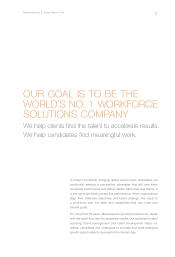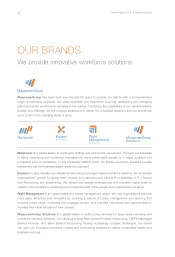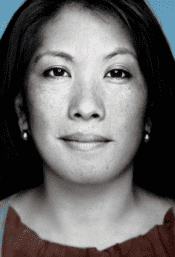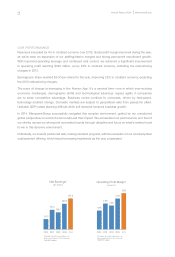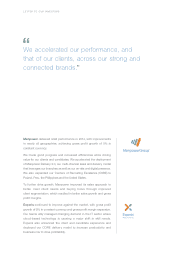ManpowerGroup 2014 Annual Report Download - page 13
Download and view the complete annual report
Please find page 13 of the 2014 ManpowerGroup annual report below. You can navigate through the pages in the report by either clicking on the pages listed below, or by using the keyword search tool below to find specific information within the annual report.
OUR PERSPECTIVE
The labor market changes once considered only cyclical are also proving to be structural, creating
unpredictability and new challenges. Developed nations are experiencing demographic shifts and having
difficulty finding people with the right skills, even as unemployment rates remain relatively high. Populations
are aging in North America, Europe, China and Latin America; meanwhile, South Asia and Africa have
predominantly young populations, but largely unskilled and undereducated workforces. Worldwide, more
than 74 million young people are unemployed.
We see skills dynamics evolving too. In 2014, talent shortages reached a seven-year high, with 36% of
employers globally unable to find the skills needed to fill open positions. We are seeing a bifurcation of the
workforce, a gap between those with in-demand skills and those without, resulting in low wage inflation
for many, growing income inequality, high levels of unemployment and pressure for more access to
education paths that provide opportunity.
Organizations we work with are increasingly applying “just-in-time” hiring practices, with options on
where and how work will be done. There’s also a squeeze on middle management now that knowledge
is universally accessible and enables flatter organizational structures. Despite the social and economic
benefits, organizations are far from reaching gender equality in the workplace, with women lagging behind
in jobs, opportunities and leadership positions.
Across the board, rapidly advancing technology is driving division in the workforce, displacing entry-level
and mid-level roles and creating new opportunities and jobs, though not always at the same pace.
Technology enables and differentiates in the changing world of work. It allows individuals greater influence
and insight, and will continue to reshape business and society at an accelerating pace.
In this environment, competitive advantage is becoming increasingly transient, and companies require
strategic and operational agility. Businesses that can strategically source, manage and develop talent will
be able to adapt, innovate and seize emerging growth opportunities. Simply put, companies need an agile
workforce strategy that enables their business strategy.
ManpowerGroup serves 400,000 clients and employs 3.4 million people across our 80 countries and
territories. From this, we know what companies need to succeed: an agile mindset and flexible workforce,
investments in underutilized talent pools and a culture of lifelong learning.
In this environment, competitive advantage is
becoming increasingly transient, and companies
require strategic and operational agility.”
“
ManpowerGroup | Annual Report 2014 11




